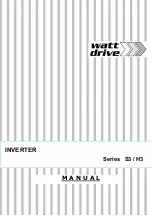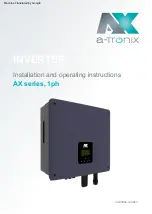
Model
Battery capacity Lead-acid
200 Ah
Battery capacity Lithium
50 Ah
Recommended DC fuse
125 A - 150 A
Minimum cross section (mm2) per + and - connection terminal
0 - 2 m
35 mm
2
2 - 5 m
70 mm
2
Consult battery manufacture recommendations to ensure the batteries can take the total charge current of the
system. Decision on battery sizing should be made in consultation with your system designer.
Use a torque wrench with insulated box spanner in order to
avoid shorting the battery.
Maximum torque: 14 Nm
Avoid shorting the battery cables.
• Undo the two screws at the bottom of the enclosure and remove the service panel.
• Connect the battery cables.
• Tighten the nuts well for minimal contact resistance.
3.3. Cable connection sequence
Connect the cables in the following order:
1. Confirm correct battery polarity and then connect the battery.
2. If required, connect the remote on-off, and programmable relay, and communications cables
3.4. Connection to the load
Never connect the output of the inverter to another AC supply, such as a household AC wall outlet or AC wave forming petrol
generator. Wave synchronising PV solar inverters can be connected to the AC output, see section on Frequency Shift Function for
more information.
The is a safety class I product (supplied with a ground terminal for safety purposes).
Its AC output
terminals and/or grounding point on the outside of the product must be provided with an
uninterruptible grounding point for safety purposes.
The is provided with a ground relay that
automatically connects the Neutral output to the
chassis
. This ensures the correct operation of the internal earth leakage switch and an earth
leakage circuit breaker that is connected to the output.
─ In a fixed installation, an uninterruptable grounding can be secured by means of the
grounding wire of the AC input. Otherwise the casing must be grounded.
─ In a mobile installation (for example, with a shore current plug), interrupting the shore
connection will simultaneously disconnect the grounding connection. In that case, the casing must
be connected to the chassis (of the vehicle) or to the hull or grounding plate (of the boat).
Torque: 2 Nm
3.5. VE.Direct
Used to connect a PC/laptop to configure the inverter.
3.6. VE.Can
Used to connect to a GX Device.
3.7. Bluetooth
Used to connect to the device via VictronConnect for configuration.
Inverter RS Smart
Page 6
Installation










































